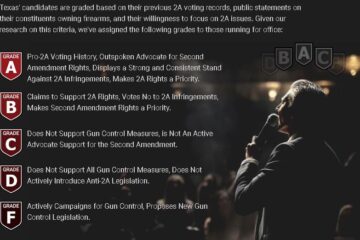Loading Bench: The 6mm Creedmoor
The count of .24-cal. rifles that remain in our home and others that stayed for a while then headed on down the road is rather high. My wife’s 6 mm Rem. has now been her constant companion for hunting deer and antelope for more than 40 years. A couple of .243 Winchester Super Short Magnums and a 6 mm HAGAR bunked in the basement for only a short time.
At least a dozen .243 Win. rifles have sat around the reloading bench dinner table at one time or another, from a Pre-’64 Winchester Model 70 Featherweight to a plain-Jane Remington Model 783. A Cooper Firearms Model 22 .243 remains because of its amazing accuracy.
A 6 mm Creedmoor chambered in a JP Enterprises LRP-07 autoloader arrived more than three years ago before any handloading data was obtainable for the cartridge. Another 6 mm Creedmoor is the newest member of the family, this one a Ruger American Predator rifle, and the pair are showing potential with handloading data now available from a variety of sources.
- Activate Your Own Stem Cells & Reverse The Aging Process - Choose "Select & Save" OR Join, Brand Partner & Select Silver To Get Wholesale Prices
- Get your Vitamin B17 & Get 10% Off With Promo Code TIM
- How To Protect Yourself From 5G, EMF & RF Radiation
- Protect Your Income & Retirement Assets With Gold & Silver
- Grab This Bucket Of Heirloom Seeds & Get Free Shipping With Promo Code TIM
- Here’s A Way You Can Stockpile Food For The Future
- Stockpile Your Ammo & Save $15 On Your First Order
- Preparing Also Means Detoxifying – Here’s One Simple Way To Detoxify
From its outset, the 6 mm Creedmoor has been promoted as a competition cartridge. Like most families, though, the shooters in our household are hunters first and only casual target shooters. So, does the 6 mm Creedmoor possess enough merit for use in hunting that we should allow it to take up permanent residence?
Let’s find out.

Bullets
Lots of .24-cal. hunting bullets are available, thanks to the decades of popularity of the .243 Win. These bullets are easily stabilized by the .243’s standard 1:10″ rifling twist and also the 1:7.7″ twist of the Ruger American Predator used to shoot the 6 mm Creedmoor loads in the accompanying table.
The trend is toward long and streamlined hunting bullets, and the Creedmoor is all about that with its fast rifling twist and seated bullets extending far outside of the case. Most such bullets that require at least a 1:8″ twist include the Barnes 95-gr. LRX, Berger 105-gr. and 115-gr. VLD Hunting, Sierra 100-gr. Tipped GameKing and Hornady 103-gr. ELD-X. Neal Emery of Hornady said the 103-gr. ELD-X was designed for the 6 mm Creedmoor. “It’s almost the same exact profile as our 108-gr. ELD Match bullet, but with the progressively thicker jacket and InterLock ring added, it has a bit less lead, and that’s why it’s lighter,” he said.

The ballistic advantage of the 103-gr. ELD-X is slight over Hornady’s new 90-gr. ELD-X that is handled by a 1:10″ rifling. Firing the 103-gr. bullet at 3000 f.p.s. and the 90-gr. at 3100 f.p.s., trajectories are the same for both out to 400 yds. The heavier bullet does carry an additional 200 ft.-lbs. of energy than the lighter bullet from the muzzle to 400 yds.
The 103-gr. ELD-X fits neatly into Creedmoor cases, its base situated half way down the shoulder, with the Creedmoor’s maximum cartridge length of 2.80.” The bullet fails to fit within a .243 Win. case. With a maximum cartridge length of 2.71″, part of the bullet’s ogive rests within the case neck, and its base protrudes deeply into the case’s propellant space.

Propellants
The Creedmoor case contains lots of space for propellant, with the base of the bullets seated at the bottom of the neck or slightly deeper. Only maximum amounts of propellants such as cylindrical H1000 and IMR 4831 are compressed when seated under relatively long bullets.
Hunter, Hybrid 100V, H4350, Superformance and Reloder 17 were stand-out propellants in accuracy and uniform velocities several years ago when I handloaded the 6 mm Creedmoor for the JP Enterprises LRP-07. I played it by ear by increasing propellant weights one grain at a time to develop loads, since no specific handloading information was available. Fairly well across the board, extreme spreads of velocity shrank as weights increased. For example, velocity spread decreased with Berger 105-gr. VLD bullets from 89 f.p.s. with 39.0 grs. of Norma 204, to 33 f.p.s. with 40.0 grs. and only 9 f.p.s. when burning 41.0 grs.

From the start, shooting the Ruger American Predator rifle, Big Game and Hornady 75-gr. V-Max bullets were a perfect match. The first three shots from the trio landed in a 0.90″ group, with 4 f.p.s. of velocity spread. Accuracy improved from there, with a 0.74″ average for five, three-shot groups and 29 f.p.s. extreme spread of velocity for 15 shots. Hunter paired with Sierra 90-gr. Tipped GameKing bullets also worked right from the start. Matching suitable propellants to Nosler 100-gr. Partitions and Hornady 103-gr. ELD-X bullets required some experimenting.
Reloder 17, Hybrid 100V and H4350 fired Partitions at about 2950 f.p.s. with extreme spreads of velocity hovering around 20 f.p.s. But bullets hit here and there across the targets. At long last, Norma MRP shrank groups to an acceptable size, although velocity was a bit slow.
Initially, ELD-X bullets strung vertical 3″ to 4″ groups shot with Hunter, Reloder 19 and Superformance—but not with each succeeding bullet continually climbing as if there was a bedding problem. Bullets were seated for a cartridge length of 2.790″, which Hornady lists for the bullet. In desperation, I continued with Superformance but seated bullets a touch deeper for a cartridge length of 2.730″. That seemingly minor change made a big difference, and bullets started printing nice, round groups.
Case stretching and case trimming were not much of a concern with the Creedmoor. A batch of Hornady Creedmoor cases measured 1.915″ after having been fired several times. Those cases measured 1.916″ after they had been sized to bump back the shoulders and slightly narrowed the case body. In contrast, the .243 Win. has nearly twice the case body taper and a more relaxed 20-degree shoulder than the Creedmoor. Fired .243 Win. cases received the same sizing treatment, and they lengthened by 0.004″ to 0.006″.

In the end, the 6 mm Creedmoor fairly well mirrors the velocity attained by the .243 Win. Like the .243, the Creedmoor shooting varmint bullets will be a great cartridge for coyote hunting, and for hunting big mule deer with Nosler Partitions. The Creedmoor’s fast rifling twist, though, somewhat extends shooting range by handling long and streamlined bullets such as the Sierra 95-gr. Tipped MatchKing and Hornady 103-gr. ELD-X.
Article by John Haviland














